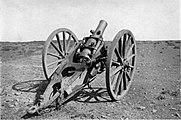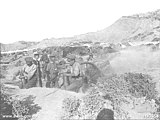BL 5-inch howitzer
| Ordnance BL 5-inch howitzer | |
|---|---|
Lyddite) )5 pounds (2.27 kg) (Amatol |
The Ordnance BL 5-inch howitzer was initially introduced to provide the Royal Field Artillery with continuing explosive shell capability following the decision to concentrate on shrapnel for field guns in the 1890s.
Combat service
Sudan Campaign
The weapon was used by the
Lyddite shells
in action.
Second Boer War
Major D Hall states that in the
World War I
By 1908 it was obsolete and replaced in British Regular Army brigades by the modern QF 4.5-inch howitzer.
East African campaign
.
A lighter 40-pound (18.14 kg) shell with
Gallipoli without range tables or fuze keys for the new pattern fuzes, rendering them useless.[7]
Gallery
-
A rear view of the BL 5-inch Howitzer.
-
Approaching Maddox Hill, Northern Cape, January 1900.
-
In action onGallipoli, 1915.
-
A BL 5-inch Howitzer in Romanian service during World War I. Romania received 28 howitzers in 1917.
Ammunition
 |
 |
 |
 |
Cordite cartridge 11 oz 7 dram Mk V, for 50 lb projectile
|
50 lb
Common shell Mk III |
50 lb
Common lyddite shell Mk IV |
T Friction tube Mk IV
|
See also
Notes and references
- ISBN 0-7607-1994-2Pg.46
- ^ Text Book of Gunnery 1902, Table XII page 336
- ^ Treatise on Ammunition 1915, accurate as at 1 August 1914, mentions that there are both "Heavy" 50 lb (23 kg) and "Light" 40 lb (18.1 kg) shells and mentions a 14 oz 13 dram cartridge for a 40 lb (18.1 kg) shell (page 142). But only 50 lb (22.7 kg) shells are listed in tables. It is possible the 40 lb (18.1 kg) shell was in process of being introduced in 1914.
- ^ a b c Hogg & Thurston 1972, page 113
- ^ Hogg & Thurston 1972 page113. Text Book of Gunnery 1902 gives 782 ft/s (238 m/s), firing a 50 pounds (22.7 kg) projectile, with 11oz 7dram Cordite size 3¾ propellant.
- ^ Hall June 1971
- ^ Simpson-Baikie 1920
Bibliography
- Text Book of Gunnery, 1902. LONDON : PRINTED FOR HIS MAJESTY'S STATIONERY OFFICE, BY HARRISON AND SONS, ST. MARTIN'S LANE Archived 12 July 2012 at archive.today
- Dale Clarke, British Artillery 1914-1919. Field Army Artillery. Osprey Publishing, Oxford UK, 2004 ISBN 1-84176-688-7
- Major Darrell D. Hall, "Guns in South Africa 1899-1902" in The South African Military History Society. Military History Journal - Vol 2 No 1, June 1971
- I.V. Hogg & L.F. Thurston, British Artillery Weapons & Ammunition 1914-1918. London: Ian Allan, 1972
- Brigadier-General Sir Hugh Simpson-Baikie, Ex-Commander of the British artillery at Cape Helles. Appendix I STATEMENT ON ARTILLERY in General Sir Ian Hamilton, G.C.B. Gallipoli Diary Vol. II. New York: George H. Doran Company, 1920
- Hogg, Ian. Twentieth-Century Artillery. New York: Barnes & Noble Books, 2000. ISBN 0-7607-1994-2Pg.46
- România în războiul mondial 1916-1919, Documente, Anexe, Volumul 1, Monitorul Oficial și Imprimeriile Statului, București. Pg. 42
Surviving examples
- At Karak Castle, Jordan
- National Military Museum, Bucharest, Romania
External links
Wikimedia Commons has media related to BL 5 inch Howitzer.
- Handbook for the 5-inch B.L. howitzer 1905 Hosted online by State Library of Victoria, Australia
- Field service manual Field artillery howitzer brigade 5-inch B.L. 1908 Hosted online by State Library of Victoria, Australia
- Handbook for the 5-inch B.L. howitzer, 1909 Hosted online by State Library of Victoria, Australia
- Handbook and equipment details for the 5-inch B.L. howitzer Mark I field batteries 1896,1901 Hosted online by State Library of Victoria, Australia
- 5 inch B.L. howitzer gun drill 1915 Hosted online by State Library of Victoria, Australia
- Great War Diary - German East Africa 1916 - of Sergeant Joseph Daniel Fewster, 1st. (Hull) Heavy Battery R.G.A.
- Bennet Burleigh, Khartoum Campaign, 1898 Describes 5-inch howitzer use in the campaign




